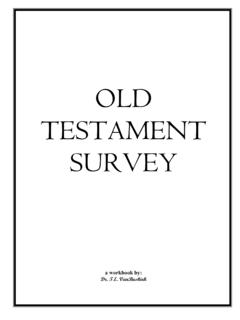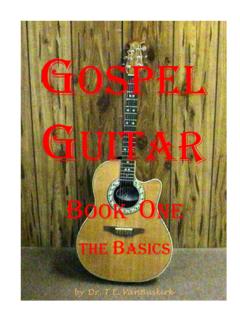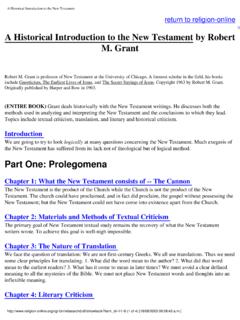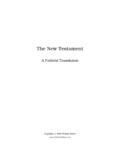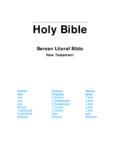Transcription of New Testament Survey - Salt Lake Bible College
1 NEW Testament Survey by:New Testament Survey 2003 & 2007 byDr. T. E. VanBuskirkNo portion of this book may be reproduced by anymeans without written permission from the to copy is granted to the purchaserfor use in their own church only but copies maynot be given away to anyone outside of the churchor sold at any time. Please send a $ love offeringto the author for each copy information on this and other materials by Dr. VanBuskirkcontact:Dr. T. E. VanBuskirkc/o Salt Lake Baptist College3769 W. 4700 , UT 84118(801) materials are also available on book was produced at the multi-media - audio-video labs of Salt Lake Baptist OF CONTENTSGENERAL INTRODUCTION AND THE INTERTESTAMENTAL PERIOD .. p. 1 General Introduction ..p. 2 The Intertestamental Period..p. 4 NEW Testament Survey ..p. 22 LUKE..p. 32 ACTS (Part One).
2 P. 37 ACTS (Part Two)..p. 42 ROMANS..p. 45 FIRST CORINTHIANS..p. 49 SECOND 54 GALATIANS..p. 66 COLOSSIANS..p. 70I THESSALONIANS..p. 74II 78I TIMOTHY..p. 83II 87 TITUS & PHILEMON..p. 90 HEBREWS..p. 94 JAMES..p. 99I & II 102I, II, III JOHN & 116 New Testament Survey p. 1 General IntroductionandThe Intertestamental Periodp. 2 General IntroductionTaylorsville, UtahSept. 9-10, 2005 This book, New Testament Survey , has been written as a companion volume to my OldTestament Survey . The two have been put together to meet a need that I have experienced inmy own ministry and even in my own Christian life in had studied the Scriptures for some 18 years but I had never had a comprehensive look atthe scriptures as an organic whole. Romans had been studied, as had Matthew, the Revelationand all the rest of the books of the New Testament . Genesis, Malachi, and all the rest of the OldTestament had been studied in like manner.
3 However, something was lacking. It took someyears but finally I realized what it was. I had, so to speak, studied the hand and the foot, the head and the legs and even how they interlocked and interacted with other portions ofthe body. What I had not done, however, was to apprehend the body as a whole. I knew theBible was an organic unity but my studies of it had been from part to part and how oneparticular part related to and interacted with other parts. What was needed, however, was anoverview of the Bible as a whole. A skeleton framework of the Bible , if you will, on which tohang the meat of further, lifelong, were a few tools available to help me obtain this goal but with most there was aproblem that loomed rather large, at least for me. Then one evening a pastor friend of mineglanced at one of the books on my study-book holder above my computer and spotted acommon Old Testament Survey book by a well-known author and commented, I had thatsame tex tbook in c ollege.
4 He then went on to say, I got so frustrated trying tounderstand it that I threw it across the room! I then realized that I wasn t the only was exactly the problem that I also faced. The common textbooks are fine as referenceworks for facts and figures but they are of no help in enabling us common folk to organize theBible into an understandable whole. That was when I decided to write a study aiming at thisone thing- to give me that skeleton framework that I personally needed so I could organizemy studies by hanging them on that framework- fleshing it out, so to speak. The regulartextbooks on Old and New Testament Survey seemed like they were never meant for thatpurpose in the first place. At least all of the ones I had ever seen and used, and that is morethan just a couple, were of no use for that purpose.
5 I needed one that was; and, since I couldn tfind one that filled the bill for me, God laid it on my heart for me to write my own. I alsodecided that it needed to be very basic- a Survey of the Bible that would give a brief I said, a skeleton framework only. That is how and why this current volume came this New Testament Survey was part of a larger study written for our SundaySchool here at Bible Baptist Church in Taylorsville, Utah, a southwestern suburb of Salt LakeCity. This original study was called A One Year Overview of the Bible and was written insegments, used one segment a week, to get us through the Bible in one year. Well, actually 53weeks if you include the Introductory lesson that preceded the start of the study lessons, but,that was close enough to one year to fulfil our purposes for Sunday 3 Since I am the Administrative Vice President of Salt Lake Baptist College , which is aministry of Bible Baptist Church, it was only natural that we also use the study in the was at that time that I broke the large study into two parts, Old Testament and NewTestament.
6 I then rewrote and reformatted each portion to fit our exact needs at SLBC andcame up with the two volumes which I then entitled, Old Testament Survey and NewTestament Survey . We now use these in the two classes called by the same names as thosetwo volumes: Old Testament Survey class and New Testament Survey two volumes are also used at our extension campuses across the United States and ineight foreign countries. In addition, our distance-learning students also use them because thestyle in which they are written and arranged makes them very easily useable for currently hold in your hands the second volume, New Testament Survey . Althougheach volume is useable independent of the other, I highly recommend that at your earliestconvenience you obtain the other volume, Old Testament Survey , and study it also so that youwill attain the goal for which the two volumes were originally written, a complete overview ofthe Bible .
7 An overview of the New Testament can be gleaned from this current volume; but,the Bible is an organic whole and you will need the companion volume to apprehend the Biblein its complete organic unity. You can build half of the skeleton framework with this currentvolume but a half skeleton leaves much to be desired. I would rather you had a complete one-which was the original goal for which I had striven for myself and for others who may use God bless you as you use this current volume and may He bless you as you pursue yourlifelong study of the Word of God. I pray that you will truly build that skeleton frameworkof the Bible for which this study and its companion were written and that they are intendedto give you. I also pray that these volumes will be a blessing to you and that God will guideyou in their use as you prepare to better serve Him by obtaining a better understanding of s Servant,Dr.
8 VanBuskirkNew Testament Survey p. 4 New Testament SurveyNOTEST h eINTERTESTAMENTAL PERIODINTERTESTAMENTAL PERIODTHE TIME OF SILENCE The Intertestamental Period began with the completion of theOld Testament . From the time of the prophecy of Elijah to comein the closing chapter of the book of Malachi (Mal 4:5-6) untilthe announcement by the angel of the impending birth of John theBaptist to his father (the priest named Zacharias in Lk 1:11-20)there ensued a period of some 400 years in which there was noword of communication from God to man. This period has beencalled the four hundred years of silence. During this periodmany remarkable changes occurred in the world that shaped thefuture history of the nation of Israel and prepared the way forJesus Christ, Messiah, also called the Son of God as well as theSon of Before and During the Intertestamental PeriodI.
9 Assyria and Babylon. (722 - 539 )A . In 722 Assyria had conquered the northern kingdom,Israel, but the kingdom of Judah remained an independentkingdom until the entrance of Babylonian influence inPalestine. In 605 , right after the fall of Egypt toBabylon at the second battle of Carchemish, Judah becamea part of the Babylonian Empire. The first deportationoccurred in 605 (Including the prophet Daniel) andmuch of the Temple treasures were confiscated under . Several Judaean rebellions occurred under king Jehoiakimand his son, king Jehoiachin, and as a consequence, in after a short three month reign of the son, the secondmajor deportation of Jews took place. At that time theremainder of the Temple treasures were removed. Also, atthis time, the young priest Ezekiel was carried away . Nebuchadnezzar then appointed Mattaniah, Jehoiachin suncle to the throne and changed his name to the advice of the prophet Jeremiah, Zedekiah alsotried another revolt with Egypt as allies.
10 Egypt failed tosupport Judah in this effort and a long and catastrophicsiege of Jerusalem began which ended with the slaughterof Zedekiah s sons and his being blinded and carried off toBabylon. At this time, 586 , the third major removalNew Testament Survey p. 5 NOTESof the people took place. In addition, the tragedy oftragedies took place for the Jewish people when Solomon sTemple was burned down; and, to add insult to supremeinjury, the walls of the city were also burned down. Thisended the nation of Judah/Israel after some five-hundredyears of existence beginning with Saul and culminatingwith the establishment of the throne of David which hadcontinued until this time and ended with . The seventy years of exile, 605 - 535 During this time we see the rise of Synagogues as places ofworship. Never meant to be a replacement for the Temple,these were simply utilized as places of worship of Jehovahas well as places of study of the Scriptures and, of course,places of Jewish fellowship.

